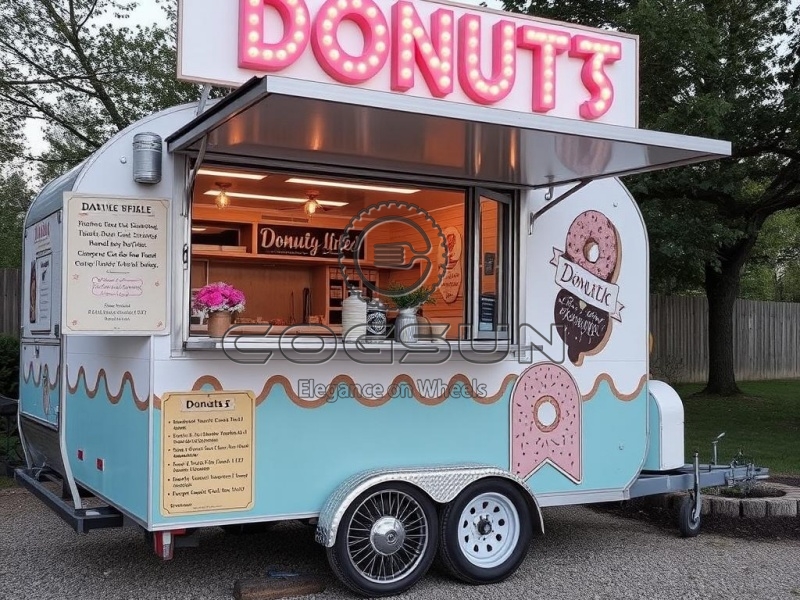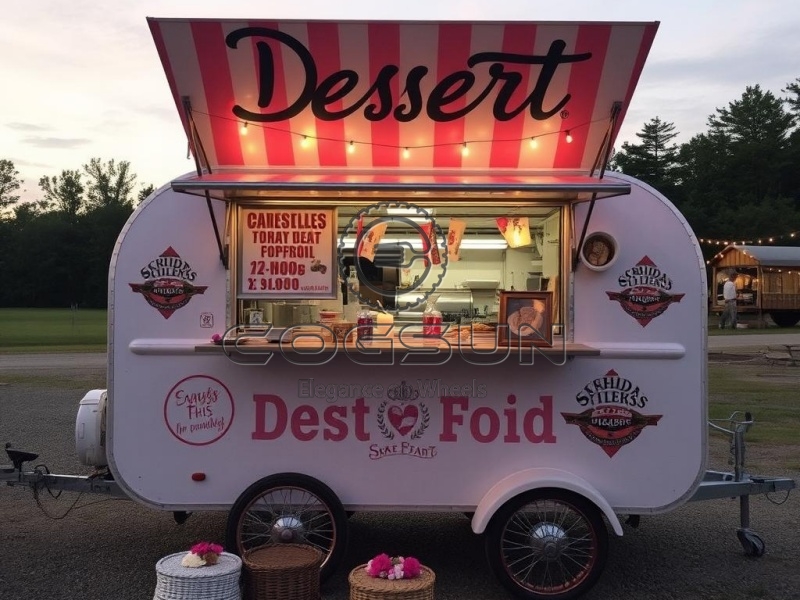The hawaii food truck doubles as a “mobile kitchen + cultural exhibition hall,” traveling to beaches, parks, markets, and even remote islands. Its exterior blends traditional Hawaiian iconography with modern minimalist design. Painted with elements like surfboards and volcanic lava, the truck is adorned with neon lights and tropical foliage, transforming it into a mobile “visual art installation.”

Features
1. “Taste Gene Recombination” through Cross-Cultural Fusion
- Signature Dishes: Volcanic Stone-Grilled Salmon Poke (Japanese sashimi with Hawaiian volcanic rock for freshness), Linguica Portuguese Chorizo Taco (Portuguese sausage and Mexican tortillas), and Taro Coconut Milk Ramen (Chinese noodles with Polynesian root vegetables).
- Innovative Model: Some food trucks partner with local farms to offer a 24-hour “soil-to-table” limited-time menu. Ingredients are harvested and delivered directly to the trucks for processing, ensuring freshness.
2. Zero-Waste Ecological Closed Loop
- Energy System: Rooftop flexible solar panels and hydrogen fuel cells enable 24-hour operation. Waste heat is used to heat drinking water, reducing energy consumption by 30%.
- Ingredient Recycling: Fish bones are used to make pet treats, coffee grounds are used to grow oyster mushrooms, and waste cooking oil is converted into biodiesel, achieving “zero waste” on-board.
- Carbon Credit Rewards: Customers who choose eco-friendly packaging (such as tamale wrapped in banana leaves) can earn points that can be redeemed for free dishes or tree planting certificates.
3. Immersive Experience Design
- Enjoy the Five Senses: The queue area is filled with the aroma of coconut and pineapple, and the AR menu virtually showcases the preparation of dishes (such as Kalua pork being roasted in an Imu earth oven).
- Themed Spaces: The volcano-themed food cart uses temperature-controlled LED light strips to simulate the flow of lava, while the beach-themed food cart offers photo props such as grass skirts and ukuleles.
Internal Equipment
1.Cooking Module
- Volcanic Stone Simulator Oven: Uses infrared technology to replicate the 360° uniform heating of an Imu oven, suitable for preparing Kalua pork. Temperature tolerance is controlled to ±2°C, and there are no open flame safety hazards.
- Ultrasonic Steamer: Utilizes high-frequency vibrations to accelerate moisture penetration, steaming taro or rice in 3 minutes while retaining over 90% of nutrients.
- Smart Grill/Grill: A built-in AI camera identifies the thickness of ingredients and automatically adjusts temperature and time. It can process up to 12 servings of garlic shrimp simultaneously, increasing serving efficiency by 300%.
2.Freshness Preservation and Pre-Processing
- Vacuum Slow Cooking Chamber: Pre-cook salmon and beef at 55°C for 6 hours. Simply grill and brown on-site, ensuring tenderness and juiciness with minimal smoke.
- Modified Atmosphere Refrigerator: By adjusting the oxygen and carbon dioxide ratio, the shelf life of poke sashimi is extended to 5 days, reducing daily food loss by 30%.
- Laser Cleaning System: Uses high-energy laser beams instead of chemical cleaners to quickly remove microorganisms from the surface of seafood and vegetables, complying with HACCP food safety standards.
3.Featured Workstations
- Poke Custom Bar: Transparent refrigerated cabinets display tiered displays of tuna, salmon, octopus, and more. Customers select their toppings via a touchscreen and watch the chef mix them live, all without contact.
- Tropical Beverage Lab: Equipped with a cold brew coffee machine, freshly squeezed sugarcane juicer, molecular gastronomy equipment, and even a nitrogen freezing zone for instant tropical fruit ice cream.
Application
1.Core Engine of the Tourism Economy
- Hawaii food trucks contribute over 40% of Hawaii’s tourism and dining revenue. For example, Lei’s Garlic Shrimp Truck on the North Shore has become an internet-famous spot for its signature garlic shrimp, attracting over 800,000 visitors annually. Its recipe has been listed as a candidate for Hawaiian Intangible Cultural Heritage.
2.Local Infrastructure
- On remote islands like Lanai, food trucks are a primary source of fresh meals for residents. One food truck tours communities three times a week, delivering affordable, healthy meal kits and accepting donations from food banks to feed low-income families.
3.Customized High-End Event Service Provider
- Private Yacht Party: A food truck offers a “snorkeling-themed menu,” featuring sushi rolls wrapped in edible seaweed and mini volcano-shaped desserts, with prices ranging up to $250 per person.
- Corporate Team Building: Customized “coding-themed packages” for tech companies, such as cookies decorated with binary code and a spicy chicken burger called the “Python Burger,” foster team cohesion.
4.Global Expansion and Cultural Export
- Some brands have expanded into the US or Asia, promoting the Hawaiian lifestyle through pop-up food trucks.




